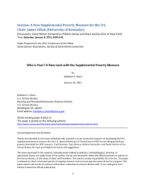
An official website of the United States government
Here’s how you know
Official websites use .gov
A .gov website belongs to an official government organization in the United States.
Secure .gov websites use HTTPS
A lock (
) or https:// means you’ve safely connected to the .gov website. Share sensitive information only on official, secure websites.
-
//
- Census.gov /
- Library /
- Census Working Papers /
- Who is Poor? A New Look with the Supplemental Poverty Measure
Who is Poor? A New Look with the Supplemental Poverty Measure
Who is Poor? A New Look with the Supplemental Poverty Measure
Abstract
This paper lays the groundwork for preparing estimates of a Supplemental Poverty Measure for the U.S. at the Census Bureau. Estimates presented here are based on the CPS 2010 ASEC and refer to calendar year 2009. These estimates differ primarily from earlier estimates for 2008 (Short and Renwick, 2010) by employing new data from the 2010 ASEC that directly collected information on necessary expenses of families and presence of mortgage. Beginning in 2010, new questions were included in the CPS ASEC to collect information about child care expenses while parents work and medical out-of-pocket expenditures, child support paid to other households, and whether or not a homeowner had a mortgage. In this paper, most of the values for these items are incorporated in the estimates presented here. Questions about energy assistance will be expanded to include the entire year, rather than just heating assistance in the winter, in the 2011 survey.
Results show poverty rates for the official poverty measure and the research SPM. The research SPM results in slightly higher poverty rates for most groups. In addition, the distribution of people in the total population and the distribution of people classified as in poverty using the two measures are examined. Generally, using the SPM results in a population classified as poor that has characteristics more similar to the total population than that using the official measure, with some notable exceptions.
Other findings show that the SPM allows us to examine the effects of taxes and in kind transfers on the poor and on important subgroups of the poverty population. As such, there are lower percentages of the SPM poverty populations in the very high and very low resource to poverty threshold ratio categories than we find using the official measure. Because noncash benefits help those in extreme poverty, there were lower percentages of individuals with resources below half the SPM threshold and smaller mean income deficits for some groups. FGT indexes suggested lower poverty gaps and poverty severity using the SPM. These findings are similar to those reported in earlier work using a variety of experimental poverty measures that followed recommendations of the NAS poverty panel (Short, 1999, 2000, and 2001).
Share
Related Information
WORKING PAPER
Supplemental Poverty Measure Working PapersSome content on this site is available in several different electronic formats. Some of the files may require a plug-in or additional software to view.
 Yes
Yes
 No
NoComments or suggestions?


Top

